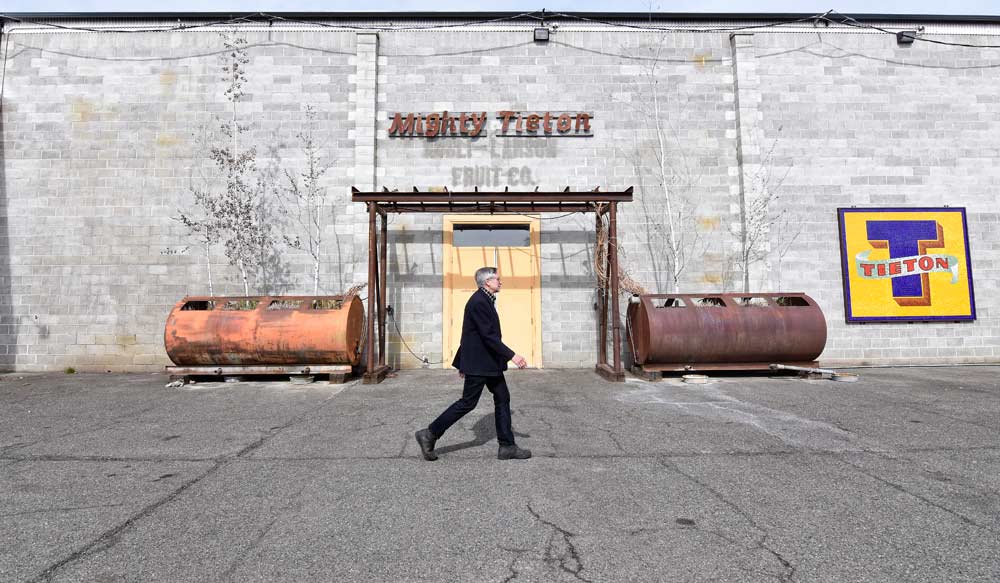
Ed Marquand, organizer of an effort to bring giant mosaic fruit labels to his town of Tieton, Washington, walks in front of a former warehouse showcasing a mosaic of a 1940s Tieton fruit label. (Courtesy Sally Tonkin)
In central Washington, you can find Tieton, dropped like a speck between enormous ridgelines.
The town never was big, but it once thrived on jobs and money flowing from the apple industry. It had a movie theater, a hotel, restaurants, grocery stores, a furniture store. You get the idea. There was enough there so people had reason to stay.
That changed as the fruit industry consolidated into fewer and bigger orchards, labor became migratory and new roads enticed people to shop and live elsewhere.
There’s still an apple industry. On the edges of town, modern packing sheds rise from asphalt. Huge trucks bearing loads of fruit rumble down those modern roads, but they don’t enter Tieton.
Today, you can walk down Tieton Avenue, do a 360 at the town square, and not see a moving car or a single thing that reminds you of the town’s deep history in apples. Not until you stop at a nearby office. There you find a trim fellow with a ready smile named Ed Marquand, who keeps labels from fruit boxes used by growers and packers in the area.
Fruit labels are deservedly loved. They reflect a showmanship and pride of place. They grab attention with curving headlines, vivid colors and lush images. Today, they are prized by collectors, framed on walls and displayed in galleries and museums.
Typically sized around 9-by-8 inches, they were mini billboards of a golden era in fruit, proclaiming grower brands with playful names or paintings of river valleys or rosy-cheeked kids chomping on healthful apples.
In Washington, labels often showed the Yakima or Columbia rivers, Cascade mountains or Lake Chelan, paradise found for distant fruit buyers.
Those labels, of course, became obsolete when fruit began moving to markets in corrugated cardboard boxes and grower brands were subsumed by giant marketing organizations, bar codes, SKUs and corporate logos. That switch definitely helped the industry.
No one can argue with marketing and distribution that yearly sells $4 billion in apples, but something was lost when those beloved labels went away.

Marquand, founder of the Mighty Tieton “incubator of artisan businesses,” stands in front one of the mosaics donated to the town of Tieton, Washington. (Courtesy Sally Tonkin)
Marquand wants to bring fruit labels back. Not all of them, just seven, but he wants to recreate them on a glorious scale, 9 feet wide and 8 feet tall, assembled from 12,000 individually hand-cut pieces of glass.
These mosaics would be permanently installed around Tieton as a legacy of the town’s history, a gift to its 1,400 residents, and an attraction for those seeking to connect with the valley’s history in a global industry.
Crazy? Marquand has been hearing that since 2005, when bicycling nearby, he rolled over thorny goatheads and suddenly his tires went pffft.
He walked into town to look for repairs and loved what he saw: a charming if worn city square.
The empty storefronts looked sad, but the buildings had bones that could be repurposed and made alive. Marquand decided to reach out to his contacts as owner of a Seattle fine art book publishing company.
That summer, he summoned friends who were architects, artists, writers, photographers and business people and asked them to brainstorm on what could be done.
And thus began what now is called Mighty Tieton (mightytieton.com), which calls itself “an incubator for artisan businesses.”
Today, Tieton has fresh paint on storefronts, a collection of artist homes, a gallery, a boutique printing press, an exhibition hall and an irresistible series of community art exhibits, “cyclekart” races, and Dia de los Muertos celebrations that draw visitors from both sides of the Cascades. The change has sparked a revival, bringing in new establishments and amping the civic pulse.
The idea for doing giant mosaic labels arose from the creation of Tieton Mosaics, which began in 2013 with a grant from the National Endowment for the Arts to help fund the creation of six large mosaics around town marking the main entry, a park and other landmarks. Tieton Mosaics has since done a variety of projects for companies and individuals.
The mosaic work is led by Steve Morgan, a local craftsman who leads a team of apprentices in the community in fabrication and assemblage, an ancient process for which there are no shortcuts. A large, complex mosaic can take a month or two to fabricate.
Recently, Morgan has been experimenting with techniques to recreate in glass the splendid color and scenes of the old fruit labels. Some labels are difficult to recreate because the original image had complex details, such as small, tight lettering.
Mosaic art, by definition, is an assemblage that atomizes up close, like a newspaper photograph under a magnifying glass. But when you step back, the eye and brain take the disparate parts and snap them together.
“The little game they play with our mind is one of the reasons why mosaics are so universally appealing,” Marquand said.
Visit www.tietonmosaic.com to learn more about the project. •
—by O. Casey Corr






Leave A Comment